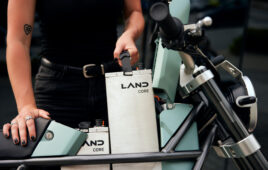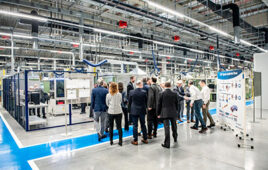Editor’s note: The technology described here is still a laboratory experiment but has promise for turning some of the CO2 generated into significant and useful power. The author does not show the calculation for the 1,570 TWh possible but we can believe that it is a lot. One thought: if successfully commercialized, it might let coal fired plants reclaim some of the power needed to run their scrubbers and for greater efficiency.
The left diagram show how CO2 disassociates an electrolyte into a useful electron. the plot shows the pulsing power generated.
A promising method for producing electricity from carbon dioxide could be the start of a trash-to-treasure story for the troublesome greenhouse gas, CO2, or so reports authors in an article in the American Chemical Society’s recently launched journal Environmental Science & Technology Letters. The method uses CO2 from electric power plants and other exhaust stacks as the raw material for making electricity.
Bert Hamelers, Ph.D., and colleagues explain that electric power-generating stations worldwide release about 12 billion tons of CO2 annually from combustion of coal, oil, and natural gas. Home and commercial heating produces another 11 billion tons. Smokestack gas from a typical coal-fired plant contains about 10% CO2, which goes to waste and is a contributor to global warming. Hamelers’ team sought a way to change that trash into a treasure.
Although details here are scant, they describe technology that would react the CO2 with water or other liquids and, with further processing, produce a flow of electrons that make up electric current. The author estimates the proves could worldwide produce about 1,570 TWh (1,570 x 1012 Wh) of additional electricity annually if used to harvest CO2 from power plants, industry, and residences. That’s about 400 times the annual electrical output of the Hoover Dam. Like the dam and other hydroelectric facilities, that massive additional amount of electricity would be produced without adding more CO2 to the atmosphere, Hamelers pointed out.
The authors acknowledge funding from the Dutch Ministry of Economic Affairs, the European Regional Development Fund, the Province of Fryslân, the City of Leeuwarden, the EZ/Kompas program of the “Samenwerkingsverband Noord-Nederland” and the European Union Seventh Framework Programme.
American Chemical Society
[email protected]
Windpower Engineering & Development
Filed Under: Green engineering • renewable energy • sustainability




